In the second research, we delved into overseas curation media. We will study the characteristics and strategies of two currently popular curation media sites, ``Buzz Feed'' and ``Upworthy.'' Although both sites have different strategies, they work well with native advertising, which accounts for the majority of their revenue. In the end, the basic monetization model was an advertising model, no different from Japan. Under these circumstances, we have found that "distributed media", which distributes content directly to each SNS without having its own website, is attracting attention as a new form of media. In fact, a new media outlet called ``Nowthis'' is putting this into practice and is considering the ``data sales model'' as a new monetization method. Since this overseas movement has not yet been observed in Japan, this research examines the possibility of success in Japanese curation media.
The key is "how to access the site"
In order for decentralized media to be effective, the key is the "method of inflow" to the site. The essential element when considering the establishment of decentralized media is the main traffic. If your main focus is on SNS, ``Rather than having your own website and trying to attract customers from SNS to your website, it makes more sense to optimize the content distributed to SNS to suit each SNS.'' It is based on thought. In other words, ``Rather than attracting users to our stores, we go to places where many users gather and open stores.'' Therefore, by analyzing the inflow traffic of each curation media in Japan, we will determine whether it is suitable as a decentralized media or not. As a first step, I would like to touch on trends in information gathering and media utilization in Japan.
According to Brainnet Press, the number of smartphone users in their 20s and older who search the Internet every day is 70% or more, and about 40% search five or more times a day. (See figure below)
[Frequency of searches on smartphones]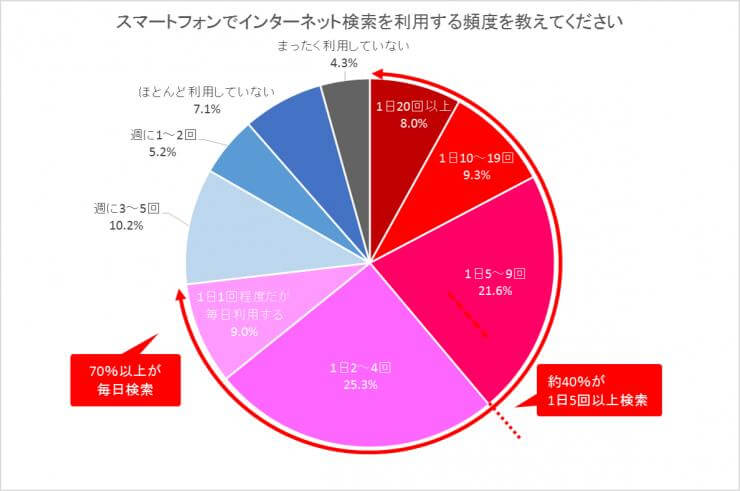
In addition, the functions and apps used on smartphones were divided into seven categories, including Internet search, browser favorites, news curation apps, and SNS apps. ”, 92.9% of users choose to search the internet first, which means almost all of them do it. Other than "interacting with friends/acquaintances," internet searches ranked first. More than half of users choose to search the internet for checking the news or shopping. (See figure below)
[Usage level by purpose/scene]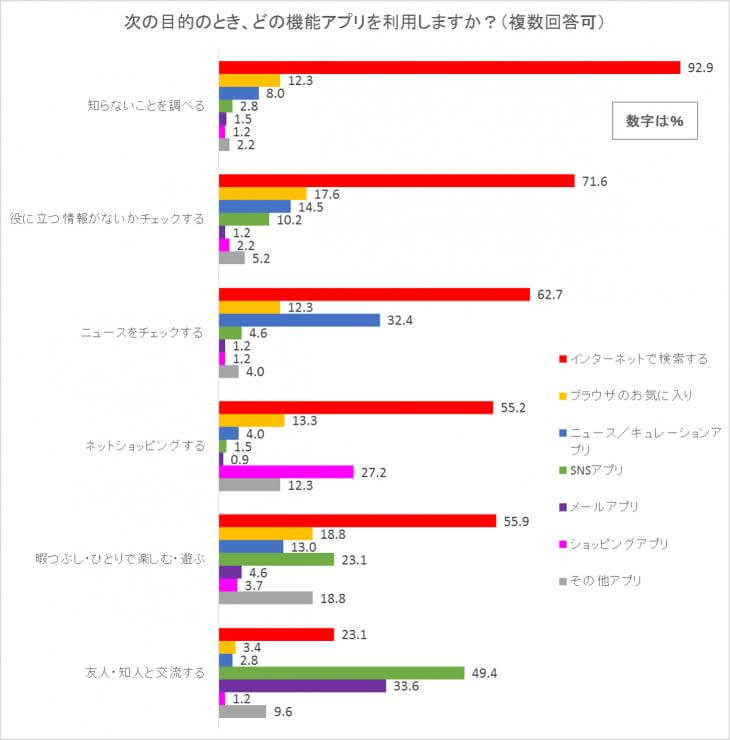
In terms of the number of websites people actually visit, Internet searches are the most visited. When users want to actively retrieve information, there is currently no solution beyond searching. It can be seen that search traffic accounts for the majority in all respects. (See figure below)
[Number of websites accessed per day]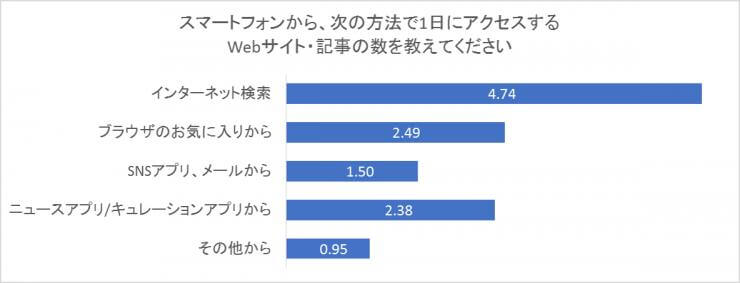
Additionally, search is a trigger for user behavior. Focusing on Internet searches, SNS apps, and news/curation apps, we will determine whether you remember the content, share content, or take specific actions (purchasing products, requesting information, making inquiries, etc.) of the websites you visited in a week. When it comes to number of content triggers, search ranks first in all three metrics. As the number of traffic to websites through search is high, it is not surprising that searches affect not only website browsing but also user behavior.
[User behavior by inflow to the website]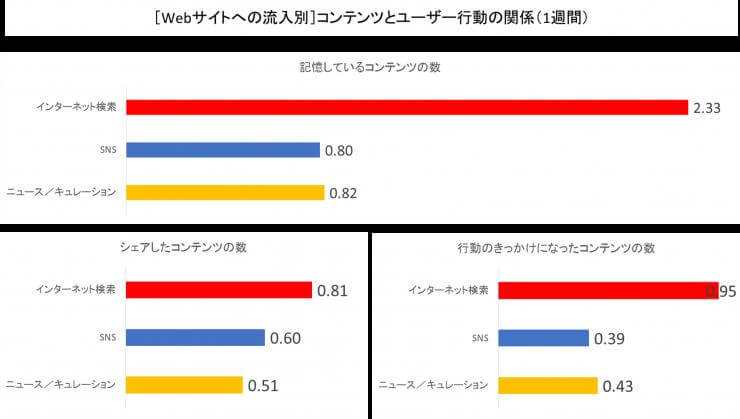
So, what about the impact per piece of content? Is there a difference in the impact on users between content accessed via search and content accessed via SNS?
Of the content accessed within the past week by users using search, SNS apps, and news curation apps,
①Memory rate = percentage of content that can be remembered
②Share rate = percentage of content shared on SNS
③Action rate = percentage of content that triggered a specific action such as purchasing a product, requesting information, or making an inquiry
When examining smartphone users, ``SNS'' came out on top in all indicators. (See the figure below) It is natural that content via SNS has a high share rate, but it also narrowly exceeds the second place search in terms of recall rate and action rate. This means that the content that users learn about on SNS is more likely to remain in their memory and become a trigger for taking specific actions. This is a beneficial result for decentralized media. If the same content can be easily remembered by users by posting it on SNS, it makes sense to optimize it by placing emphasis on distribution on SNS.
[Remember rate/share rate/action rate based on inflow source]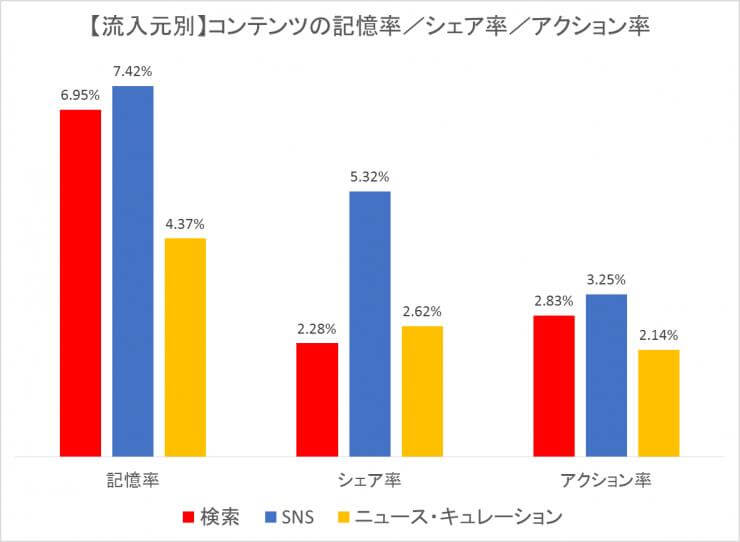
Including the above data and other factors, we can summarize the characteristics of search, SNS, and curation...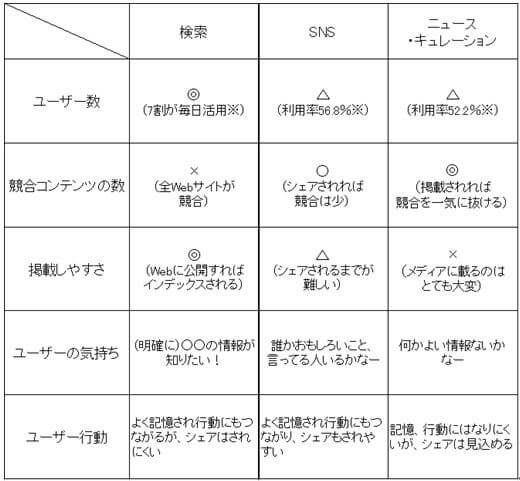
While search remains powerful, there are more and more ways to deliver content. Although it is best to use multiple approaches effectively, the biggest weakness of search engines is that they prepare content on the Web and use a "wait and see" tactic to respond to users' search needs. On the other hand, SNS and curation media have the strength of being an "offensive" tactic that you can use from your side. As SNS has both "offensive" and "spreading" characteristics and is becoming an infrastructure for users, it is highly likely that the presence of decentralized media will increase in the future. (See figure below)
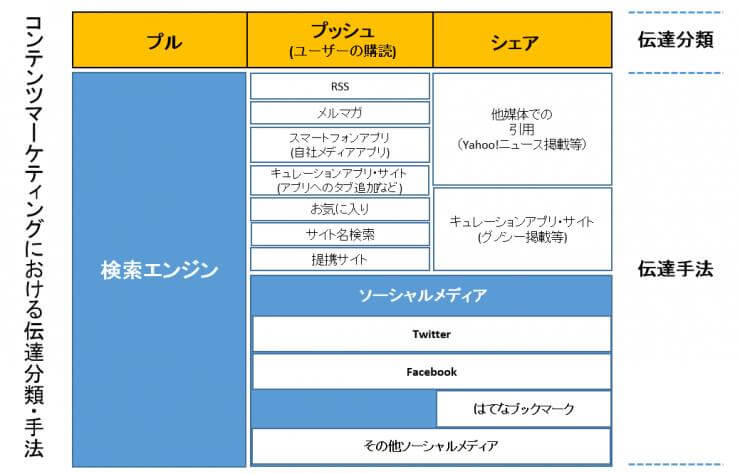
Japanese curation media traffic analysis results
Up to this point, we have touched on trends in information gathering and media utilization in the Japanese market as a whole. From here, we will analyze each currently popular curation media. Below is an overview.
①Analysis method
Using SimilarWeb (free version)
②Analysis items
I. Basic information
II. Traffic sources
III. SNS source
IV. Discussion
③Target site
NEVER summary
Gunosy
Antenna
MERY
Nanapi
NewsPicks
NEVER summary
I. Basic information

II. Traffic sources
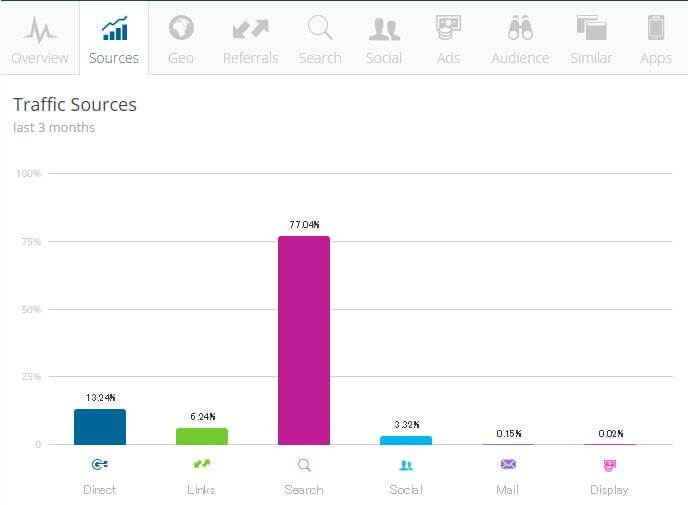
III. SNS source
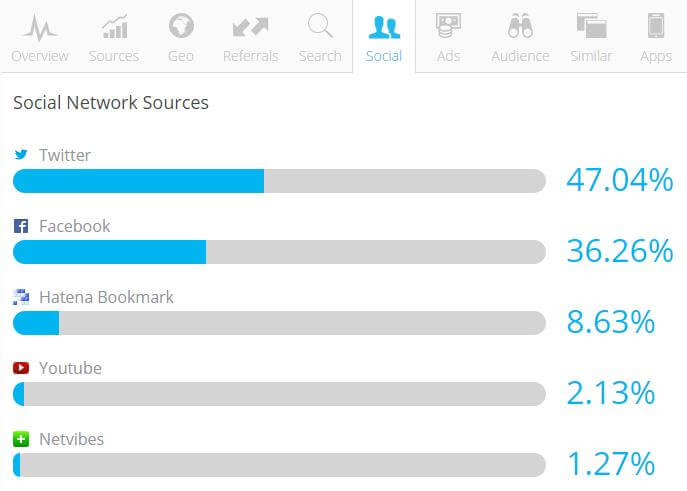
IV. Discussion
The number of monthly visitors is overwhelmingly around 71 million. Since the inflow from search is 77%, it is thought that users are searching for "NEVER summary". We believe that we are attracting a large number of users due to our popularity as a pioneer in curation media and the wide range of content we handle.
And above all, the point is that Twitter has the most inflow of SNS. Among the curation media we investigated this time, it is the only one with a large number of Twitter users. What can be inferred from this is that the NEVER summary format is highly compatible with Twitter. What do you mean? NEVER Matome summarizes the necessary information from multiple sites in one concise sentence. In other words, with NEVER Matome, users can quickly find interesting content without spending time. This means you can tweet immediately. Similarly, people who retweet can easily understand the content using the NEVER summary. In short, NEVER Matome satisfies the needs of a provider of tweet material. A feature of Twitter, unlike Facebook, is that posting time is fast. On Facebook, users take a certain amount of time to post things that have happened to them, along with photos and other information. On the other hand, Twitter is just about "tweeting," and it's meaningful to be able to tweet what's on your mind right away, without having to take the time to think about what to post. In this way, apart from the credibility of the content, the ``simplicity'' of NEVER Matome is what makes it the number one inflow from Twitter.
Gunosy
I. Basic information

II. Traffic sources
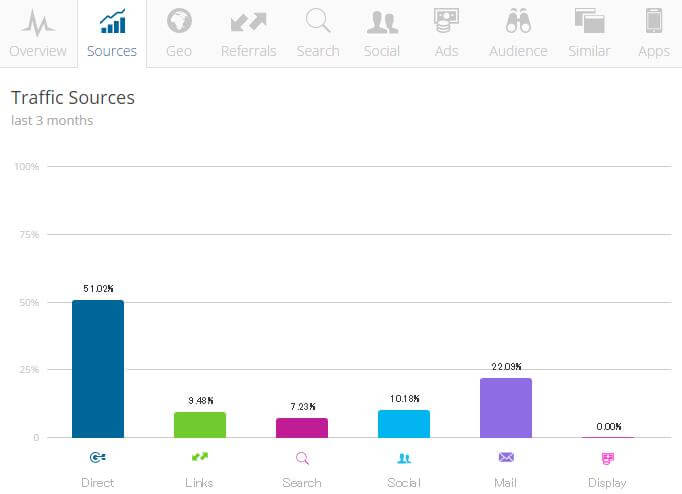
III. SNS source
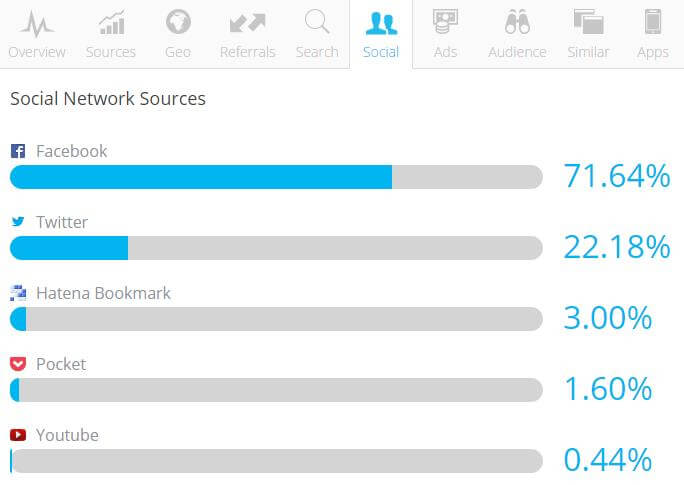
IV. Discussion
The reason why it has a large number of users among curation media is because it is a newspaper format. News is a consumer product that everyone needs, so it doesn't have to be targeted. Next to Smart News, Gunosy, a pioneering news app, receives the most traffic through direct traffic. This is proof that Gunosy, a site/app for getting news, is well established among many users. Another characteristic is that the second largest number of inflows comes from email. Newspapers are a habitual thing to read every day. Email is also something I check habitually. The affinity between two people with the same habits probably increases the number of inflows from email.
Antenna
I. Basic information

II. Traffic sources
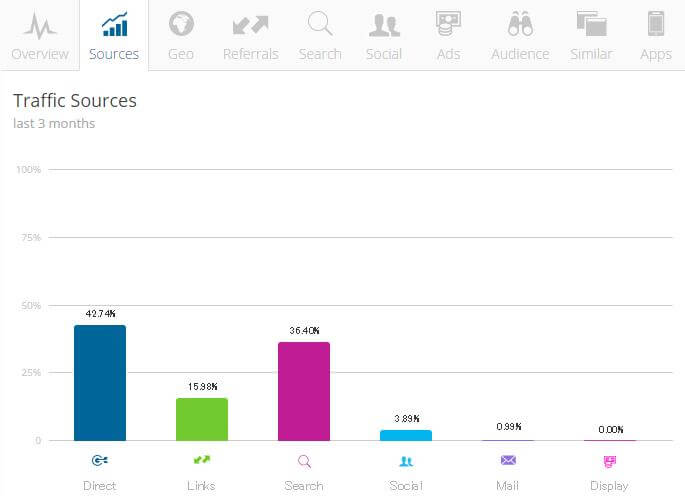
III. SNS source
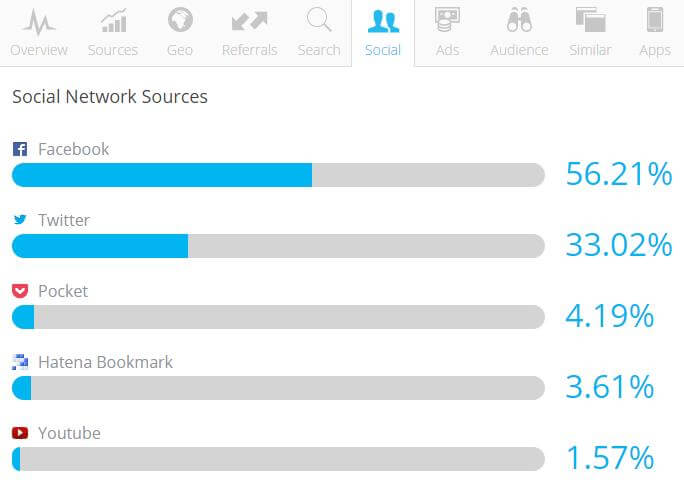
IV. Discussion
Antenna is a representative of magazine-type curation media. On October 1st, the app was completely renewed. At the same time, we have changed our policy by enhancing the functionality of the app itself, such as by making it possible to customize pages to suit users' preferences. If you register keywords, genres, etc. related to the information you want, each time that article is distributed, it will be saved in your My List. We have also added a function that allows you to smoothly obtain regional information by using location information.
In order to arrive at valuable information, there is no point in finding valuable information unless the pooled articles have value in the first place. Therefore, Antenna narrowed down its search to ``media that provide the information that users want.'' In line with the renewal, the number of affiliated media (excluding content partners such as music companies) has been reduced from approximately 400 to approximately 250. Specifically, the latest articles from "Huffington Post" and "TABI LABO" are no longer displayed on the antenna. Articles that are no longer displayed on Antenna are distributed by "media that essentially do not directly cover the subjects they cover" (Tetsuya Sugimoto, president of Glider Associates). It is a type of media that mass-produces articles by copying the main parts of articles that are popular on other sites, or distributes articles with the main purpose of guiding people to advertisements in the original article.
Many curation media such as SmartNews and Gunosy, which have emerged in the past few years, have partnered with various web media and accepted articles. This is to increase the number of users by enriching the content. No matter what kind of website you are in the beginning, it is inevitable to value quantity over quality. However, when it becomes difficult to survive in a red ocean situation, it is natural to place importance on "quality." This antenna decision clearly changed the trend.
MERY
I. Basic information

II. Traffic sources
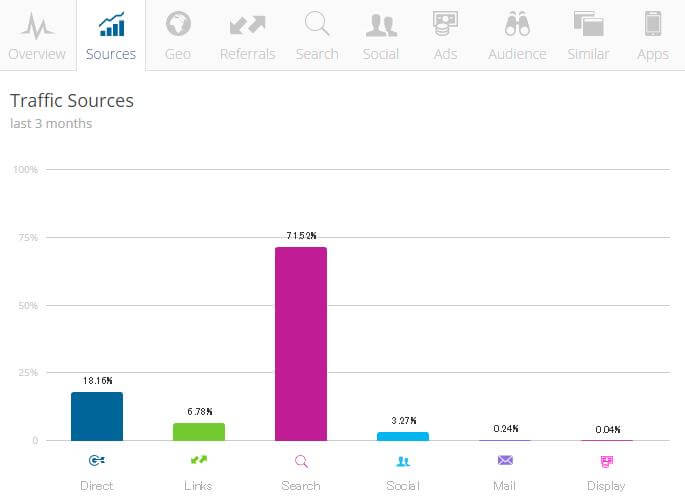
III. SNS source
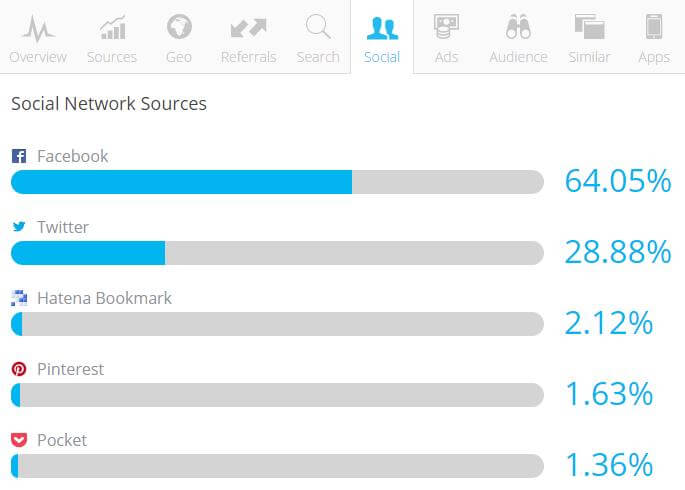
IV. Discussion
MERY, the number one comprehensive curation media for women, provides information that is familiar and can be immediately incorporated into daily life. The needs of female users of this media are not to know unusual information, but rather information that is useful in daily life. In order to meet the needs of such users, we provide information that is familiar and can be immediately incorporated into daily life. In addition, it is a vertical media similar to Horizontal in that it provides comprehensive summaries about women. Of course, a wide range of user numbers is allowed. We introduce products from brands registered as official brands on MERY, such as apparel, fashion goods, and cosmetics, and provide a link to our e-commerce site to meet the needs of our readers. Since MERY is a major curation media for users, most of its revenue comes from the advertising model.
Nanapi
I. Basic information

II. Traffic sources
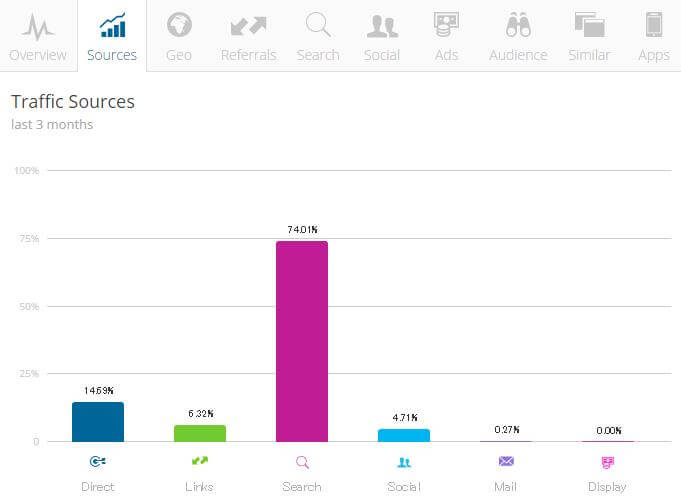
III. SNS source
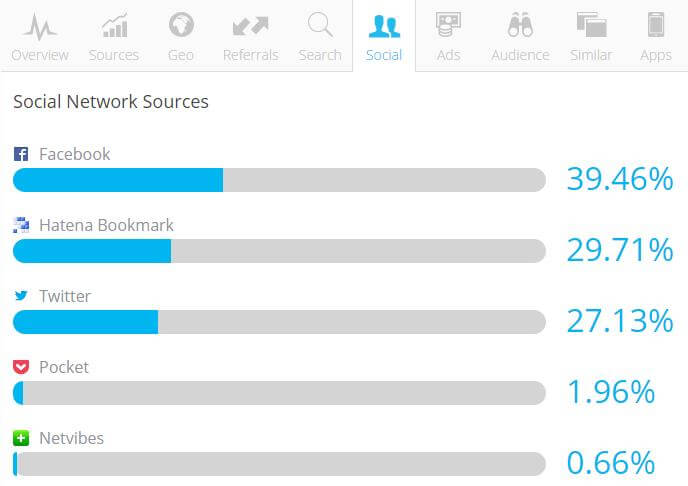
IV. Discussion
Nanapi, like MERY, is a comprehensive curation media that provides wisdom and know-how for daily life. The genres and categories of content are wide-ranging and can be called horizontal media. The key point of Nanapi's strategy is that although it has a wide range of content, it is not news. In other words, it is not a "consumer good" whose value fades over time, but rather a capital goods type of curation media where the more you read, the more you will educate yourself, so we expect an influx of repeat and regular users. Another point is that Hatena Bookmark has the second highest number of traffic on SNS. I think this is because many users bookmark Nanapi for daily life knowledge and know-how on what to do in situations like this.
NewsPicks
I. Basic information

II. Traffic sources
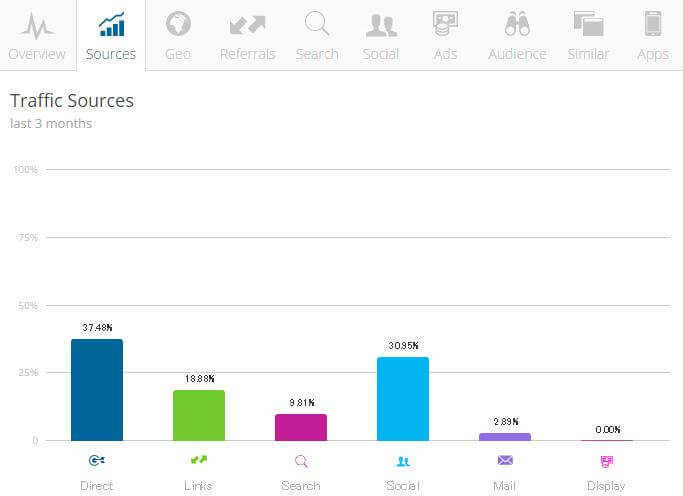
III. SNS source
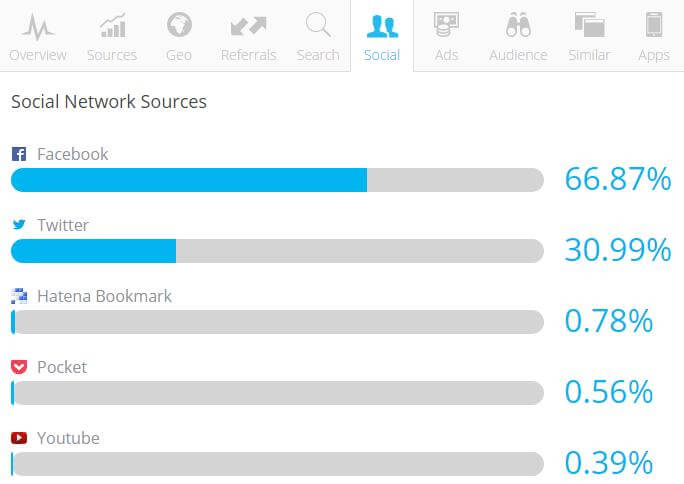
IV. Discussion
NewsPicks, a typical vertical media, has a large number of user stays and views. This is because it is area specific. The specialized and deep content is what makes the billing model, which is NewsPicks' main monetization model, successful. You can see from the graph that providing high-quality articles earns support from users and leads to increased engagement.
Summary of analysis results
The above are the analysis results and considerations regarding the influx of six curation media. This is summarized in the table below.
[Curation media matrix]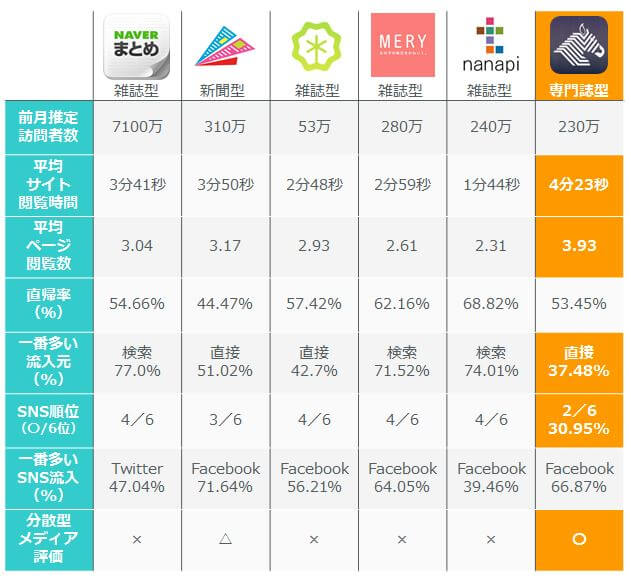
What you should pay attention to is NewsPicks. Although NewsPicks is only one of these six sites, it has the best site viewing time, average number of page views, and SNS ranking compared to the other five sites. NewsPicks and Gunosy are the two sites with the most direct traffic, and both rank relatively high in SNS traffic. In this way, media with high engagement is likely to be checked by users on other SNS pages other than your own website as well. The results show that NewsPicks' strategy type, ``specialized magazine strategy,'' has potential for becoming a decentralized media. Based on these results, I realized that next time I would need to verify whether similar results could be obtained with curation media that adopt other specialized magazine strategies. Japan is characterized by many specialized curation media, so there may actually be many media that meet the conditions of decentralized media.
conclusion
Key points for curation media to succeed as decentralized media in Japan
① Vertical media (specialized magazine type strategy)
Although it is still a hypothesis, through this traffic analysis, we saw the possibility that NewsPicks, a curation media that uses a specialized magazine strategy, could become a decentralized media. NewsPicks is a vertical media specializing in economics and business. So, why do vertical media have so many inflows, both directly and via SNS? This is because users are formed by regular users, and regular users are a group with a high level of engagement, which will be discussed next. In other words, NewsPicks users are high-quality customers who visit regularly because they want to see content. High quality = There is a high possibility that you have bookmarked, followed on SNS, or added to your favorites. Therefore, there is a lot of direct and SNS inflow. If the number of people viewing the content of the curation media on SNS is higher than the inflow rate on SNS, it may be more appropriate to distribute it as a decentralized media.
②High engagement
NewsPicks has a high number of visitors and at least high engagement, so it can be said that it provides value as a media to users. This is evidenced by the fact that compared to the other 5 sites, site viewing time, average number of page views, and SNS ranking are the best, and the bounce rate is also the second best. In this way, if engagement is high, there is a high possibility that people are checking the content and latest articles of the curation media on SNS, including the website. I think that will increase the inflow rate from SNS. However, for users who like the curation media's homepage and visit it for fun, decentralized media and turning it into an in-house site may actually cause them to leave. Therefore, the idea of getting rid of your own website and optimizing it on SNS because you get a lot of traffic from SNS may be extreme. The key to this is how the users of SNS feel about the influx. Decentralized media is not suitable for users who find it troublesome, but the starting point for information acquisition is SNS, and users who flow in for the purpose of curation sites.
③ SNS/direct traffic to your own website accounts for the majority of the total
This can be said to be the minimum necessary condition for decentralized media, but considering the fact that Japan has the lowest rate of SNS inflow in the world in the second study, Japan is the only curation media with a high rate of these two factors. It is a special media in the market. On the other hand, Japanese users tend to use a wide variety of methods to obtain information, including curation media and SNS. In order to establish a position as a medium for acquiring information on SNS, there may be an option to move away from creating an in-house site and turning to a decentralized media. In addition, direct inflows are repeat and fixed users who have bookmarks, etc., so it is possible that they are using the site because they ``like the site.'' The risk of losing users by moving away from in-house sites is a concern.
Optimizer considerations
When using distributed media with Optimizer, the first step is to actively distribute content on Facebook and acquire visitors. The reason for this is that awareness of the traffic to our own sites is still low. On the other hand, the number of actions (likes, etc.) on the optimizer is gradually increasing due to promotion on Facebook. From this point of view, the solutions team must continue to actively disseminate information on Facebook.
Currently, the main focus is on raising awareness through PPC advertising and increasing the number of inbound visitors, which is strongly characterized as "paid media." However, in the future, it will have to evolve as "earned media" to gain reputation and trust from consumers. In other words, each SNS provides a "place" for consumers to obtain information. This is also the goal of decentralized media. So what kind of content should you specifically distribute on SNS? This R&D, which is being promoted throughout the company, is content that can be evolved into a Facebook page as earned media. In addition to this, we will regularly distribute articles such as "New Power School (tentative name)" that introduces various things related to new electric power, "Business Phone Now (tentative name)" related to unlimited business phones, and other marketing theories. This will lead to further enrichment of content. In particular, the number of people who like the Shindendenryoku page is increasing. Not providing more useful information from the optimizer is a big challenge.
Therefore, first of all, we will actively distribute content on Facebook, and then we will acquire the number of users and develop our branding. From there, by gradually rolling out horizontally to each SNS, it will be possible to accelerate recognition and branding of Optimizer through decentralized media in the future. SNS will definitely become infrastructure in the future. In other words, we can expect success from decentralized media. While it is currently difficult to turn established curation media into decentralized media, the lack of recognition may be an advantage for optimizers who become decentralized media.
Initiatives for next time
Next time, we will conduct traffic analysis in the same way as this time, targeting other Japanese vertical media. By finding vertical media that has as many inflow routes from SNS as NewsPicks or more, we will verify whether vertical media can truly function as a decentralized media. If the results contradict our hypothesis, we conclude new features and points that could become a decentralized medium.
source
https://www.similar-web.jp/ "Similar Web Official HP"
http://www.brain-solution.net/blog/news-release/newsrelease_0625/
http://www.brain-solution.net/blog/content-marketing/sankanou/
https://ferret-plus.com/880
http://toyokeizai.net/articles/-/86417 "Why Antenna ended its contract with HuffPo"
http://itpro.nikkeibp.co.jp/atcl/news/15/093003152/ “Curation app “Antenna” has been reorganized to reduce publication media by 40%” http://markezine.jp/article/detail/23157“Curation magazine “antenna*” has renewed its logo! To make partner media more elite by reorganizing content.”
![]()
Back issues of this series
Part 1: Analysis of curation sites and research on their growth potential
Part 2: Examination of the strategy of overseas curation media that has not yet arrived in Japan, and its business model and monetization
Related recommended pages
Comprehensive web strategy consulting
[calltoaction01]